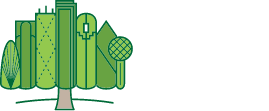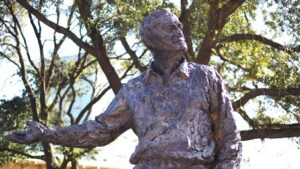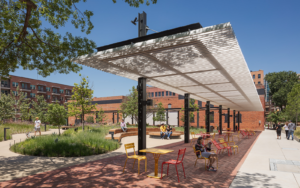Its beginnings may be modest, but work on Carpenter Park — a park that will stretch from DART’s Pearl Street Transfer Center to the western edge of Deep Ellum — is already underway. In March of this year, workers began dismantling “Portal Park Piece (Slice),” 1981, one of the City’s iconic works of public art, in preparation for the sculpture’s reincorporation into a green gateway to downtown Dallas. MacArthur Genius Award-winning sculptor Robert Irwin will not simply be relocating the 700 feet of steel comprising “Portal Park Piece (Slice)”; he will be reimagining it, retitling it, and integrating it into the park plans designed by Hargreaves Jones.
Dallas is fortunate to retain the services of Hargreaves Jones. The firm is the recipient of a 2016 National Design Award for Landscape Architecture from Cooper Hewitt. In their citation, Cooper Hewitt praises Hargreaves’ versatility and sensitivity to the needs of local communities, noting that its designers have a proven track record of success transforming “neglected urban sites, waterfronts and campuses into memorable places.”
In a recent conversation with Downtown Dallas Parks Conservancy, Mary Margaret Jones, Hargreaves president and senior principal designer, spoke about her company’s vision for Carpenter Park and commitment to Dallas’ revitalization efforts.
What makes Carpenter Park unique?
Carpenter Park will significantly expand and transform from its current condition with the elimination of freeway off-ramps and other roadway modifications. Not only will it be a vastly improved park, but also it contains an early work by the internationally renowned artist Robert Irwin, who responded to the new context by repositioning his piece “Portal Park Piece (Slice),” which is a site-conditional work of art that will now speak to the past as well as the future of the park and the city.
What are your thoughts on incorporating more quality green spaces into downtown Dallas?
We’ve been working on this issue for a number of years with the Downtown Parks Master Plan, its update, the realization of Civic Garden (formerly known as Belo Garden) and now Carpenter Park. We know the incorporation of green space and making downtown more pedestrian friendly will make it a better place to live, work and play, and we have seen that proven true with the realization of each new park, just as we have seen that be true in cities across the nation. Our experience in Dallas and elsewhere has also proven the economic benefits of such amenities — mixed-use development follows the creation of a successful public realm and the cores of cities are revitalized as a result.
We know you’ve been involved with the Dallas Park and Recreation Department. Please tell us a little about those projects. Which was your favorite to work on and why?
We were first involved as the design lead for the Fair Park Master Plan that envisioned a future for Fair Park as a successful public park, cultural amenity and daily destination for neighbors and visitors, as well as the home of the State Fair and the Cotton Bowl. We then led the Downtown Parks Master Plan and its subsequent update, which in combination laid out a strategy for making Dallas competitive with other similar cities in the country in terms of downtown open space and quality public realm. We were particularly honored to work on the realization of one of the signature downtown parks identified in the plan, Civic Garden, and to work with those who believed in the importance of landscape and gardens to the quality of life in downtown and who made Civic Garden come to fruition. It is immensely rewarding to watch people use and enjoy the park.
How do you feel the Civic Garden has contributed to the downtown Dallas community?
Civic Garden is unique within the context of the other downtown parks, as a place foremost for respite and enjoyment of the landscape: the Texas Grove of trees, the texture and color of the garden plants, the splashing arcs of water that invite interaction and the promontory created by the hill. The Downtown Parks Master Plan outlined a framework for the signature parks, envisioning each of them to be different in character and use, and Civic Garden was seen as a green gateway to downtown and a place for passive enjoyment, with an emphasis on landscape. This goal has been well met as Civic Garden has proven the wisdom of replacing downtown surface parking lots with green space and creating a place for people to escape from the urban environment within the city.
People of all ages use the park whether to play in the water, enjoy lunch among the gardens, sit in the shade or perch on the hill to be a part of — but removed from — the busy life of the city.
How do you see your specific project changing the way people visit and experience downtown Dallas?
Carpenter Park will provide a new open space amenity in a part of the city that is growing and changing rapidly, with new residential and cultural developments and a DART stop to the east, and a revitalizing downtown to its west. The park will create an open-space connection between these districts and provide green space for a neighborhood where there is little to none. It also is an entrance to the city and will present a green gateway to downtown for vehicular traffic and pedestrians.
Carpenter Park overcomes and mitigates the impact of the overhead freeway, using the particular conditions to create a dynamic recreational environment with non-traditional and traditional park uses. And the re-positioning of “Portal Park Slice” will create something entirely unique both within the body of a renowned artist’s work and within the array of downtown parks in Dallas, providing a gateway to the park, slicing through the landscape and animating the plaza beneath the freeway where visitors will frequent the café and food trucks.
How do you see all four of PFDD’s projects affecting the downtown Dallas area in the next five years? The next 10 years?
The realization of all four parks will build on the success of Civic Garden, Main Street Garden and Klyde Warren Park, creating a system of urban parks that will link one to another, making a dramatic difference to the walkability of downtown and the quality of life for all who live, work and visit there. The parks will offer a variety of amenities and each will be different in character, providing distinct destinations, relief from the urban environment and incentives to be downtown — as a resident, visitor, worker or investor.
Over time there will be more mixed-use development downtown and more opportunities for transforming underutilized land into open space.
What is your favorite amenity or design feature you’ll be implementing in the park?
My favorite design feature is the meandering granite walk and hedge that will wind through the site, touching each feature and contrasting the straight line of Robert Irwin’s “Portal Park Slice.” This walk and hedge, which will be comprised of a variety of plant types, will create human scale on the site, define zones and add a whimsical element to the park that will engage visitors.
There are a number of amenities that will draw people to the park, but we know from experience that the interactive water feature will be particularly popular and be a prominent visual marker along Pacific Avenue.
Are there any fun facts or things the general public may not already know about the park or location that you’d like to share with us?
“Portal Park Piece (Slice)” by Robert Irwin weighs 83 tons (165,500 lbs.) and was removed by unbolting the artwork from the foundation and cutting over the original welds with a plasma torch, creating 20 segments, each 30-feet long. Each piece was then lifted by a crane with only two magnetic clamps set directly on the steel. The pieces were labeled and placed onto racks and transported to a City of Dallas facility where they will be restored.
“Portal Park Slice” will come back when the park is complete — but it won’t be quite the same. It will be re-positioned and slightly transformed based on the artist’s new vision.
What are one or two of your favorite parks you have visited in the U.S. or around the world?
It’s hard to beat Central Park in New York City, where I live. And our project in San Francisco, Crissy Field, which converted an airfield into a national park on the bay, is one of my favorite places to walk whenever I am there.
What’s one city you think is “doing it right” in terms of urbanization in their downtown area? How do you think Dallas will compare once the four parks are built?
In Oklahoma City and Houston we are involved in park projects that are transformative for their downtowns. Discovery Green in Houston has already become a catalyst for social and economic change in the six years since it was built, with new mixed-use development surrounding it and more than a million visitors last year. And the 70-acre park we are currently designing for Oklahoma City will connect downtown to the river and create valuable adjacent development sites that will expand the urban core to the river.
With the realization of the four new parks for Dallas there will be a linked system of contemporary parks in downtown, a web of open space amenities that will transform the overall fabric of the city’s core. This will make Dallas unique among comparative cities.
Carpenter Park and the expansion of our Downtown park system is an ambitious undertaking. The City needs the help of its citizens to transform an under-utilized green space into an active and vibrant park that will create a more welcoming and walkable connection between downtown and near East Dallas. Get involved and stay involved by following Downtown Dallas Parks Conservancy on Facebook and Twitter, and sign up for our newsletter.





